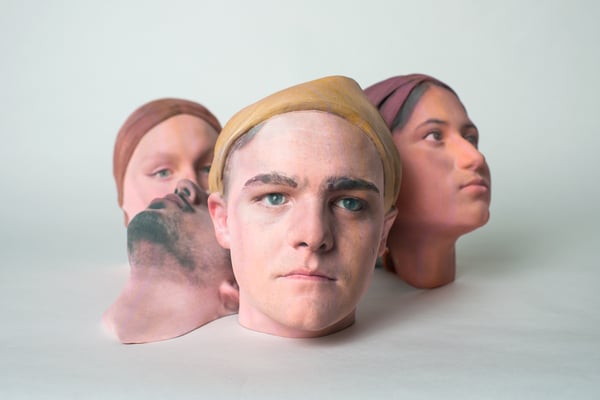Passive Liveness Detection Testing: How Masks are Used to Test Reliability
Share this article:
Halloween is over, but masks are still as popular as ever… and we aren’t talking about COVID masks. Criminals are using hyper-realistic masks to commit identity fraud every day.
These masks are extremely detailed, with incredibly realistic features like hair, freckles, and wrinkles. Some will even mold to the face to mimic facial expressions. They aren’t hard to find, either. A quick google search shows plenty of sites dedicated to realistic masks - you can even find them on amazon.com.
In response, a growing number of organizations around the world are using facial recognition to enable security and provide better customer experiences. Facial recognition is growing in popularity as biometrics has become the safest way to verify someone’s identity. The drivers behind the widespread adoption of biometrics include the rising number and severity of hacking attacks (like this notable one involving a fake French minister), the rise of cloud computing and storage, and the demand from consumers and businesses alike for fast, secure, accurate ways of verifying their identities.
And that’s where the challenge of facial recognition comes in. Hackers are constantly developing new ways to subvert biometrics, forcing companies to develop tests that validate the accuracy of their facial recognition solutions.
The Importance of Liveness Detection
One of the primary tests that companies use to test the accuracy of facial recognition and authentication technology is passive liveness tests.
But first, a quick primer on facial liveness detection. Facial liveness detection is a technology that determines if the face being presented to a facial-recognition system is “live.” In other words, it determines if the face is of a living person who is looking into the camera, or if the face is, instead, a 3D mask, a video, a high-resolution photo, or a cut-out photo.
Active liveness detection typically requires the subject to do something, such move their head, nod, blink their eyes, or move their lips, to prove that they are not fake.
Passive liveness detection, on the other hand, is an AI-based method of ensuring that a face presented to a facial recognition system is live. Passive liveness detection is “passive” because it doesn’t require subjects to do anything. Users are not required to perform any motion tasks to prove they are live. Plus, the system typically performs this detection in the background, giving no indication to users that they’re being tested.
Passive liveness detection relies on algorithms that identify and assess parts of an image indicating its content, such as skin, borders and texture. It also detects if masks or cutouts are present, and if any other methods are being used to give a false representation of a user’s face. Since the process doesn’t alert the user in any way, it’s tougher for fraudsters to figure out how to circumvent passive liveness detection systems.
Passive Liveness Detection Testing
So, how do we ensure that IDmission passive-liveness is best-in-class?
As you can imagine, passive liveness detection is only helpful if it’s accurate. One way to validate its accuracy is with tests conducted by third-party labs. These tests are critical to mitigate fraud, detect imposter attacks and maintain confidence in facial detection as a method of verifying identity. (In fact, we’ve recently announced that our biometric identity verification technology now meets the ISO/IEC 30107-3 Level 2 biometric Presentation Attack Detection Standard (PAD).
One way that labs test passive liveness detection systems is with masks. They present a person wearing a mask and
then present a person without a mask, and measure to see if the system accurately spots the fake face (the mask) and spots the true face.

In a passive liveness test, the false face is called the “species.” Species include:
- Photographs on smartphones
- Flat paper photographs
- 3D sculptures
- Videos on smartphones
- 3D prints
- Cut-out masks
- Rubber face masks (made from latex and silicone)
A cut-out mask is a life-size photo of a face with the eyes cut out. The fraudster holds the photo up in front of their face and looks through the eyeholes to make the face appear live.
Latex and silicone face masks cover the entire face, typically giving a complete head-and-shoulders likeness of a person (head, hair, ears, face, neck). These masks are typically pulled over the head. They feature empty eye openings that the wearer’s eyes look through.
In fact, at our IDmission headquarters in Boulder, Colorado, we have a room full of these masks to test the technology ourselves. It’s a pretty strange site, to walk in and see dozens of masks with varying degrees of realism. But it’s all to ensure that our technology is best-in-class.

Passive liveness detection tests with masks involve presenting the species to the system 150 times and presenting the real face to the system 50 times. If the system accepts the mask as true, the test fails.
How is Your Business Authenticating Customers?
Facial recognition technology has come a long way during the last few years, particularly with the emergence of passive liveness detection, and is now a top choice for businesses to authenticate their customers.
The global facial recognition market was valued at USD 4.4 billion in 2019, and it is projected to be valued at USD 10.9 billion by 2025, registering a CAGR of 17.6% over the forecast period, 2020-2025 (Mordor Intelligence LLP).
Your business can benefit from facial recognition technology. Whether you’re a tech startup, a retail business, or a large business with thousands of employees nationwide, your employees, customers and suppliers are already accustomed to encountering facial recognition in daily life—and are open to it as a method of identifying their identities.
But regardless of whether you’re using facial recognition software or another type of identity verification software, you must ensure that you’re using the best and most up-to-date solution for your business needs. That means working with a vendor that uses passive liveness detection systems that are tested in third-party labs and are ISO certified.
About IDmission
IDmission provides biometric technology solutions that orchestrate digital transformations for companies relying on identity and ID verifications. We utilize standards compliant security, passive liveness biometrics, AI, and industry expertise for businesses to create an effortless end to end customer journey.
Many vendors claim to have tools that detect passive liveness, but their “solutions” still require users to zoom their phones in and out to prove liveness. IDmission is totally frictionless, with a snap-and-go technology. Unlike other vendors, we do not have to send the image up to a server to determine liveness. We do it in a split second—right right from your user’s phone.


Leave a Comment